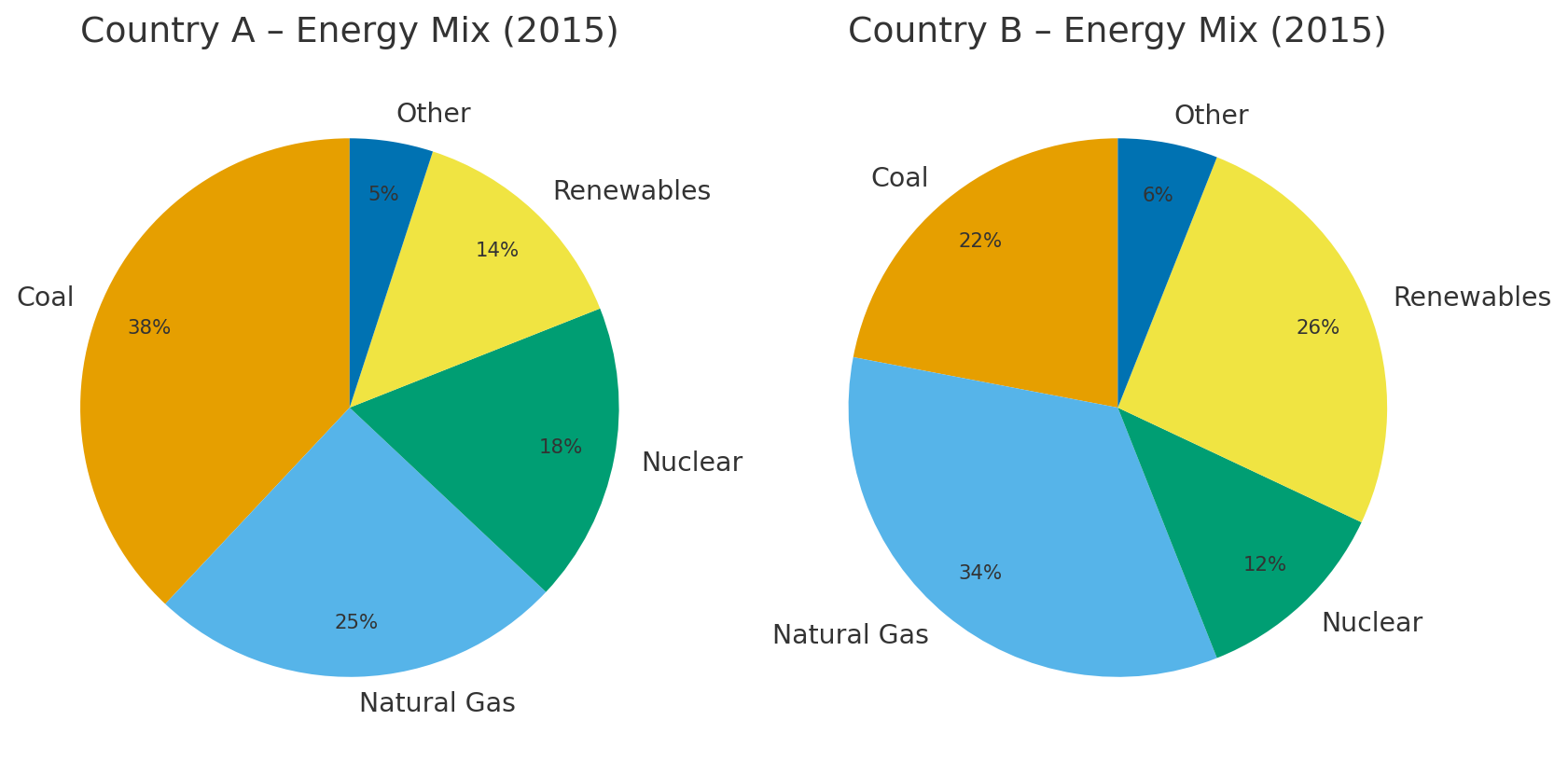IELTS Academic Writing Task 1 – Sample Test07 (Collection Pie Charts)
Task Question
The pie charts below compare the energy mix by source (coal, natural gas, nuclear, renewables, other) in two countries in 2015.
Summarize the information by selecting and reporting the main features, and make comparisons where relevant.

Figure: Energy source shares in Country A and Country B (2015)
Sample Answer (Band 7.5–8)
The two pie charts compare how electricity generation was distributed across five energy sources in two countries in 2015. Overall, Country A relied heavily on coal, whereas Country B’s production was more diversified, with natural gas and renewables playing larger roles.
In Country A, coal was by far the dominant fuel, accounting for 38% of output. Natural gas formed a substantial secondary share at 25%, while nuclear energy contributed 18%. Renewables represented a comparatively modest 14%, and the residual 5% fell into the “other” category. By contrast, Country B generated the largest proportion of its electricity from natural gas, at 34%. Notably, renewables were also significant at 26%, outstripping coal (22%) by several percentage points. Nuclear accounted for only 12%, and “other” sources made up the remaining 6%.
Taken together, the charts indicate divergent priorities: Country A pursued a coal-centric strategy, while Country B emphasized cleaner or more flexible options, particularly gas and renewables. Consequently, B’s portfolio appears less carbon-intensive and better balanced than A’s, which remained anchored to traditional fossil fuels.
Analysis of the Answer – IELTS Writing Task 1
✅ Strengths
- Clear overview highlighting contrasts between Country A (coal-focused) and Country B (diverse energy mix).
- Wide lexical resource: terms such as “coal-centric strategy,” “divergent priorities,” “less carbon-intensive” are precise and academic.
- Logical flow with clear paragraphing: introduction, detail paragraphs, and overall conclusion.
❌ Weaknesses
- Lack of explicit numerical comparison in mid-sentence (e.g., “renewables outstripped coal by 4%”).
- Sentence structures are mostly compound; more conditional or concessive clauses would raise grammatical range.
- Limited variety in discourse markers; “whereas” and “by contrast” are repeated.
💡 Suggestions for Improvement
- Include intermediate contrasts: “Renewables were 4 percentage points higher than coal in Country B.”
- Vary sentence openings: instead of “In Country A...,” try “While Country A relied on coal, Country B leaned on gas and renewables.”
- Use cause-effect: “This pattern reflects an effort to reduce reliance on carbon-heavy fuels.”
- Employ conditionals: “Had Country A invested more in renewables, its portfolio would have resembled that of Country B.”
🔄 Useful Synonyms
- “soared” → “skyrocketed,” “climbed steeply”
- “remained low” → “stayed subdued,” “persisted at minimal levels”
- “increased significantly” → “rose markedly,” “expanded sharply”
- “lagged behind” → “trailed,” “consistently fell short”
🔗 Cohesive Devices & Collocations
- Whereas, in contrast, nevertheless, conversely, albeit
- Collocations: energy portfolio, reliance on fossil fuels, diversified mix, upward trend
- Academic tone connectors: “It is evident that…,” “This suggests that…,” “By comparison…”
🎯 Band Justification
The response demonstrates strong task achievement, wide lexical range, and clear organization, justifying a Band 7.5–8. To consistently reach Band 9, the candidate should integrate a broader variety of grammatical structures and expand analysis with precise figures and advanced connectors.
📊 IELTS Writing Task 1 – Analysis / تحلیل پاسخ
✅ Strengths / نقاط قوت
- Clear overview highlighting contrasts between Country A (coal-focused) and Country B (diverse energy mix).
- ✔️ مقدمه و جمعبندی شفاف است و بهطور مستقیم تفاوتها را برجسته میکند.
- Wide lexical resource with academic expressions like “coal-centric strategy,” “divergent priorities.”
- ✔️ واژگان آکادمیک متنوع و دقیق به کار رفته که برای نمره بالا ضروری است.
❌ Weaknesses / نقاط ضعف
- Lack of explicit numerical comparison in mid-sentence (e.g., “renewables outstripped coal by 4%”).
- ❌ به دادههای میانی (مثل سالهای 2005) اشاره نشده که عمق تحلیل را کاهش میدهد.
- Sentence structures are mostly compound; more conditionals would raise range.
- ❌ ساختارهای پیچیدهی گرامری کمتر استفاده شدهاند؛ تنوع بیشتر نیاز است.
💡 Suggestions for Improvement / پیشنهادهای بهبود
- Include intermediate contrasts: “Renewables were 4 percentage points higher than coal in Country B.”
- 🔹 از اعداد دقیقتر برای مقایسه استفاده کن (مثلاً "در کشور B انرژی تجدیدپذیر ۴٪ بالاتر از زغالسنگ بود").
- Vary sentence openings: e.g., “While Country A relied on coal, Country B leaned on gas and renewables.”
- 🔹 شروع جملات را متنوع کن تا متن یکنواخت نشود.
- Employ cause-effect: “This reflects an effort to reduce reliance on carbon-heavy fuels.”
- 🔹 رابطه علت و معلولی را نشان بده؛ این باعث میشود تحلیل حرفهایتر شود.
🔄 Useful Synonyms / مترادفهای مفید
- “soared” → “skyrocketed,” “climbed steeply”
- 🔹 "افزایش شدید" → جهش کرد، رشد چشمگیر داشت
- “lagged behind” → “trailed,” “fell short”
- 🔹 "عقب ماندن" → عقب افتاد، کمتر باقی ماند
🔗 Cohesive Devices & Collocations / انسجام و همآیندها
- Connectors: Whereas, in contrast, conversely, albeit
- 🔹 حروف ربط قوی: در مقابل، با این حال، برعکس
- Collocations: energy portfolio, reliance on fossil fuels, diversified mix
- 🔹 همآیندها: ترکیب انرژی، وابستگی به سوختهای فسیلی، سبد متنوع
🎯 Band Justification / توجیه نمره
The response justifies Band 7.5–8: strong task achievement, wide vocabulary, and logical flow. To reach Band 9, the candidate should add more complex structures and deeper analysis with precise figures.
این پاسخ بین ۷.۵ تا ۸ است؛ چون انسجام، واژگان و وضوح خوبی دارد. برای رسیدن به ۹ باید ساختارهای پیچیدهتر و تحلیل عددی دقیقتر اضافه شود.
